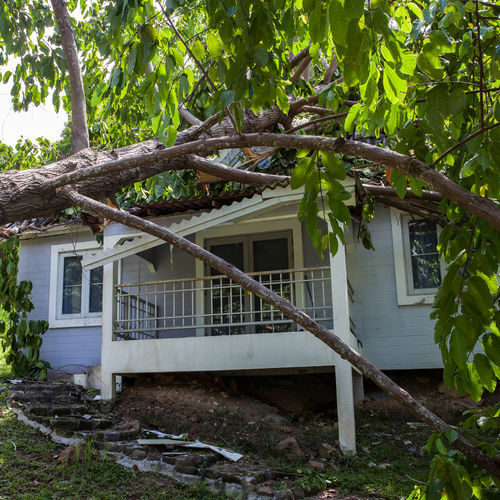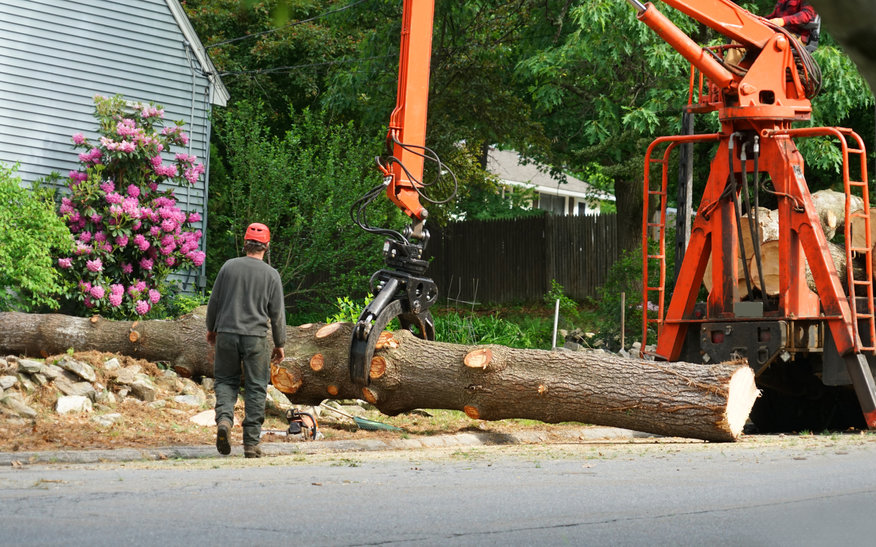
Tree Removal Processes
Many times, we buy a house because of the trees surrounding it. In fact, in the real estate world, the trees are a value-add when it comes to the listing price. However, as beautiful and loved as having trees around your home are, there comes a time that tree removal is necessary.
When should you consider tree removal?
When possible, tree removal should be the last course of action, and simply because a tree is dead, doesn’t mean it must be removed. If the tree is in an area where it can’t harm anyone or anything, leave it be as a refuge for wildlife.
However, dead, dying, or a tree that is hazardous with the possibility of causing expensive and extensive damage, tree removal is the best option. So, tree removal should be performed if any of the following exist:
- Indications of infection: Crown dieback, deep cracks in the bark, discolored or misshaped leaves, crumbling soft wood, or the presence of fungi often indicate infection. A tree full of unwanted pests, indicated by beginning holes, feeding galleries, and busy woodpeckers feeding on the tree.
- Large, dead branches: When these are in the crown of the tree, described as widow-makers because they will fall for what appears as no reason and can cause serious injury. When fifty percent or more of the tree is damaged or dead, tree removal is a matter of safety.
- Poor growth: Discolored, thin foliage and stunted growth indicate a tree is having trouble, especially if all the trees around it are healthy and vigorous. Tree removal may be necessary, but have the tree inspected by a professional first.
- Root defects: Root defects are not always easily noticeable, but if there are fungi and heaving soil near the tree base, tree removal should be considered.
- Compromised trunk: Cracks, dead branch stubs, large wounds, or splits in the trunk indicate the tree is dying inside. A tree can live for years in this situation, but it is just a matter of when it becomes too weak and falls.
- Hollow: A hollow tree trunk is a compromised tree trunk and creating a hazard. If 1/3 of the tree is hollowed or rotted, tree removal is recommended.
- Suddenly leaning: A leaning tree isn’t necessarily dangerous, but if that lean has happened without an apparent cause suddenly, there is likely a structural problem with the tree, and tree removal is the safest course of action.
- Sprouting at the base: A tree with sprouts at the base isn’t having babies. These are epicormic shoots, indicating the tree is stressed and should be inspected by a professional.
- Power lines: A tree that has grown into power lines is hazardous and tree removal is recommended. If the tree is too close to your home and is hanging over the roof, keep it pruned or schedule a tree removal.
What do I need to know before removing a tree, how do you protect your property during tree removal?
If you feel that tree removal is necessary, you should have it inspected by a certified arborist first. They will determine if the tree should be removed or if there is a treatment to save the tree.
If the tree is well-rooted and healthy, there are different ways to remove it than how a dead or diseased tree removal is done. The same applies to how old the tree is as well. By examining the tree, a professional arborist can determine important facts and advise the best process and tools for tree removal.
Next, you’ll need to clear your yard so that the tree can lay flat once the tree removal has brought it down. The recommended clearing space is two times the tree height. This area should be all around because you won’t know what direction the tree is coming down.
Make sure no, cars, pets, people, or lawn furniture in the vicinity. The tree removal company will survey the area regarding power lines, so the tree removal doesn’t cause issues for your neighbors. Make sure there is a clear path for the tree removal crew to go back and forth and work around the tree.

Why is tree removal important?
There are several reasons that tree removal is necessary:
As a dead or sick tree loses strength and weakens, it becomes unable to withstand the ice, snow, storms, and wind. The limbs and branches can break off, the tree can fall, causing major damage, even death.
A diseased tree left standing can spread the disease to other trees. Tree removal will prevent this from happening. A tree that has been damaged has been weakened, and tree removal could be the best way to keep it from unexpectedly falling.
Sometimes, as beautiful as trees are, when they are encroaching the power lines or the foundation of your home, they are becoming a problem. When trees are planted, perhaps the shade was the focus, but as they grow, they can get in the way of driveways, sidewalks, or too close to a structure.
Is it safe to remove trees close to the home?
Yes, after you’ve had a professional examine the tree and its proximity to your home, having a professional tree removal is safe, usually making it safer for your home.
What steps are taken for safe tree removal, What is the tree removal process?
It is always recommended to have any tree removal done by a professional service. They will have the proper equipment, safety gear, and tools to do the job safely and thoroughly. A professional tree removal company will have procedures in place that will assure the tree is brought down safely using the following steps:
- Estimate the felling zone and allow room for the fall
- Cut a notch into the tree, placing a wedge there to help direct the tree down
- As they cut, they watch for kickback limbs
- A rope is used as they guide the tree down to keep the tree away from power lines and structures
- Branches and limbs still on the tree are removed and trimmed for easier removal once it is on the ground
Do you need a permit to remove a tree?
In Texas, no, there is no law requiring a permit to be obtained for tree removal.
In Closing
Many homeowners wonder can you plant a tree where one was removed? While you certainly can, after all, it is your property. However, arborists recommend not to because the essential nutrients for healthy growth are likely stripped from the soil, especially if the tree was diseased.
Tree Spark provides smooth tree removal in Fort Worth, TX. Call (817) 717-7737 to get scheduled.
